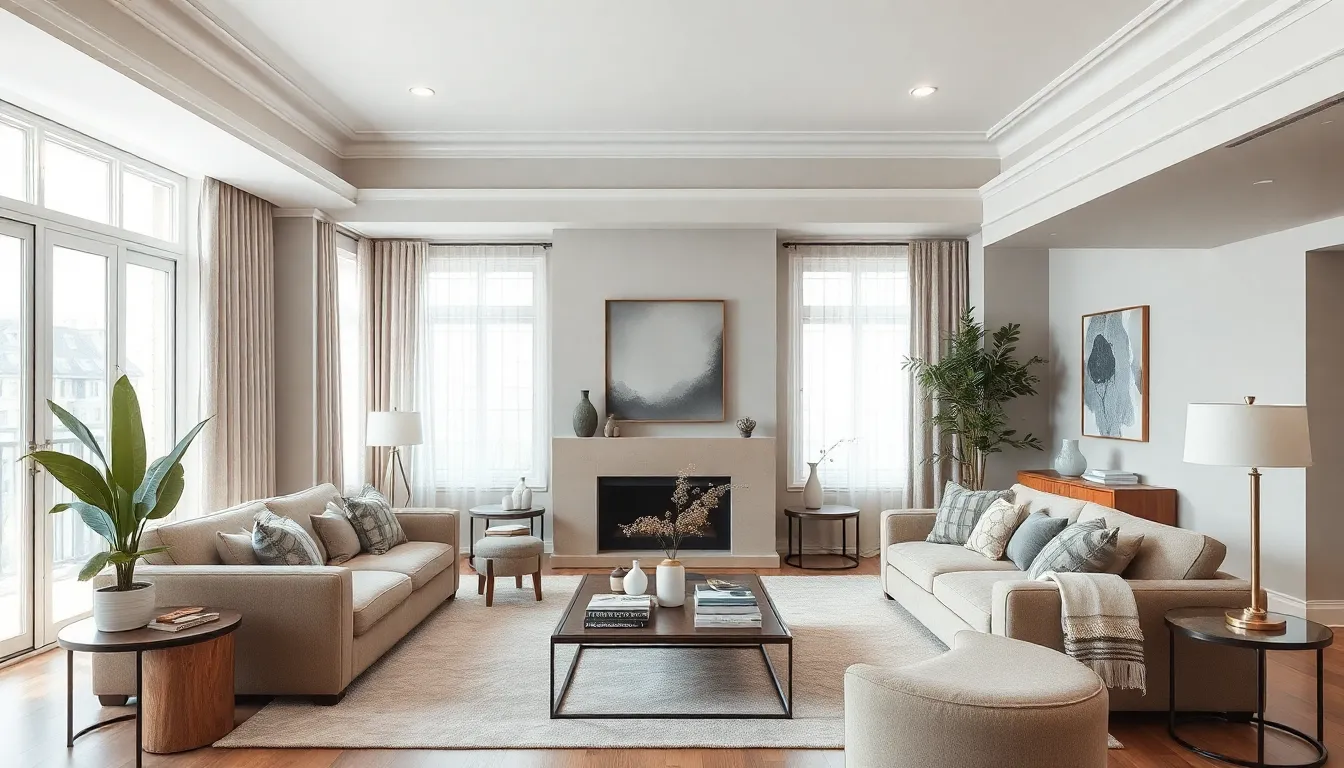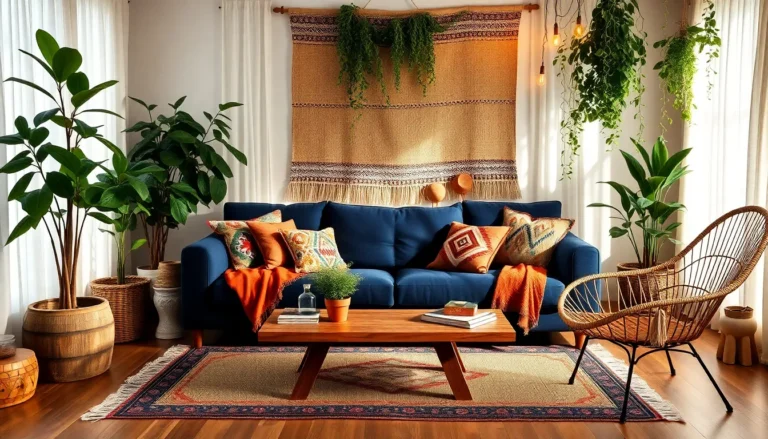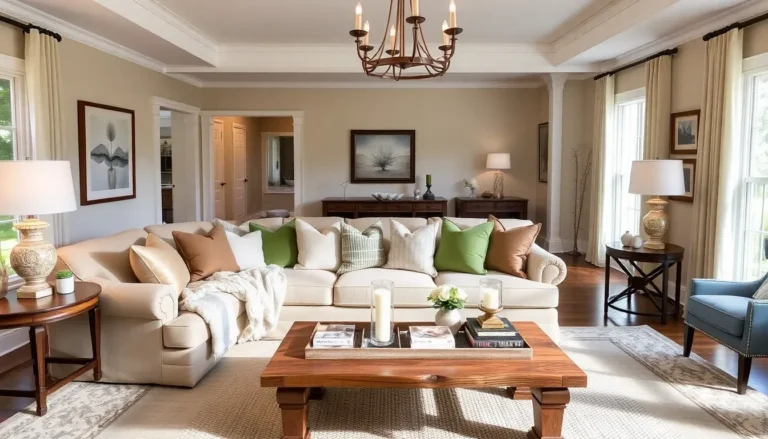Table of Contents
ToggleChoosing the right color scheme for a living room can feel like picking the perfect avocado—too green and it’s a disaster, too ripe and it’s just sad. The living room is the heart of the home, where laughter echoes and memories are made. So why settle for drab walls that suck the life out of your space?
Overview of Color Schemes for Living Rooms
Choosing a color scheme for a living room significantly influences the overall atmosphere. Vibrant colors, such as reds, yellows, and oranges, create an energetic and lively environment. Additionally, neutral tones like whites, grays, and beiges offer a calming backdrop, ideal for relaxation.
Complementary color schemes often involve pairing colors opposite each other on the color wheel. For example, blue and orange can work harmoniously together. This approach adds visual interest while maintaining balance.
Monochromatic schemes focus on varying shades of a single color, providing a sophisticated look. Light and dark shades of green, for instance, can evoke tranquility while allowing for distinct layers and textures.
Using an analogous color scheme features colors that sit next to each other on the color wheel. This method promotes harmony and can lead to a serene living space. Greens, blues, and yellows have a natural feel that many people find appealing.
Incorporating bold accents can enhance a chosen color scheme. A neutral base, paired with vibrant pillows or artwork, creates focal points without overwhelming the design. Similarly, adding textures through rugs or curtains can create depth and interest within the space.
Considering the lighting is crucial when selecting colors. Natural light can alter the way colors appear throughout the day, impacting mood and ambiance. Experimenting with paint samples can provide clarity on how colors interact with the room’s lighting.
All these factors—color choice, scheme type, and light—contribute to establishing a welcoming and engaging living room atmosphere.
Popular Color Palettes

Choosing the right color palette enhances the living room’s vibrancy and atmosphere. Various palettes cater to different styles and preferences, enabling personalized décor.
Neutral Color Schemes
Neutral color schemes offer versatility and sophistication. Shades like beige, taupe, and gray provide a calming backdrop that complements various décor elements. Soft whites can brighten the room, while darker grays add depth. Homeowners often layer different textures and materials to create visual interest within these palettes. Furniture in earthy tones pairs effortlessly, promoting a tranquil environment. Accent pieces in muted colors add subtle pops without overwhelming the space.
Bold Color Combinations
Bold color combinations infuse energy and personality into a living room. Vibrant reds, deep blues, and striking yellows create focal points that capture attention. Pairing complementary shades enhances visual contrast and excitement. Accent walls in passionate colors can serve as a dramatic highlight amid neutral furnishings. Choosing accessories in bold hues often ties the room together, adding dimension and flair. Bright artwork or statement furniture can further enrich the overall aesthetic, making it lively and inviting.
Tips for Choosing Color Schemes
Choosing the right color scheme transforms a living room into an inviting space. Consider the following tips to maximize the aesthetic of your area.
Consider the Size of Your Space
Space dimensions influence color choices significantly. Bright shades can make a small living room feel larger and more open. Darker tones, while cozy, may overwhelm confined spaces. For expansive areas, combining several colors adds depth and dimension. Using lighter colors on walls and darker accents in furniture creates balance. A strategic mix allows for both comfort and style, catering to diverse preferences.
Natural Light and Its Impact
Natural light affects color perception and mood. Sunlight brightens hues, making them appear more vibrant. Dark rooms may benefit from lighter shades to reflect available light. During different times of the day, colors can shift dramatically, so it’s beneficial to observe how a color looks from morning to evening. Consider testing samples on walls to see how they interact with the light. Balance is key, as adequate light can enhance or diminish a color’s appeal, directly affecting the room’s ambiance.
Using Color to Create Mood
Color choice significantly influences the mood of a living room. Warm colors like red, orange, and yellow evoke feelings of energy and warmth, creating an inviting atmosphere. Cool colors, including blue, green, and purple, promote tranquility, perfect for relaxation. Homeowners often prefer neutral tones, such as beige or gray, to establish a calming backdrop that allows for flexibility with decor.
Accent colors enhance mood and visual interest. Bold hues like turquoise or fuchsia infuse vibrancy into the space, serving as focal points. Layering these colors through accessories or artwork creates richness and dimension, drawing attention without overwhelming. Individuals seeking harmony may opt for analogous color schemes, which utilize colors adjacent on the color wheel to maintain a cohesive and serene environment.
Consider natural light’s impact when selecting colors. Rooms filled with sunlight can handle deeper shades, influencing how colors appear throughout the day. Conversely, dimly lit rooms benefit from lighter colors that reflect available light, making the space feel more open and inviting.
Testing paint samples on walls helps visualize the final outcome. Observing how light interacts with different shades ensures the desired mood is achieved. Understand that color perception varies, so choosing shades that feel right in context is essential.
Ultimately, balancing colors according to personal style creates an engaging living area. By selecting appropriate hues and considering how they interact with light, homeowners can cultivate a vibrant and welcoming mood in their living rooms.
Choosing the right color scheme for a living room is essential for creating a vibrant and inviting atmosphere. By understanding the effects of various colors and how they interact with light and space, homeowners can make informed decisions that reflect their personal style. Whether opting for bold hues or calming neutrals, the chosen palette should enhance the room’s character and warmth. It’s all about finding the perfect balance that resonates with the residents and their lifestyle. With careful consideration and creativity, the living room can become a true reflection of home, filled with energy and comfort.








